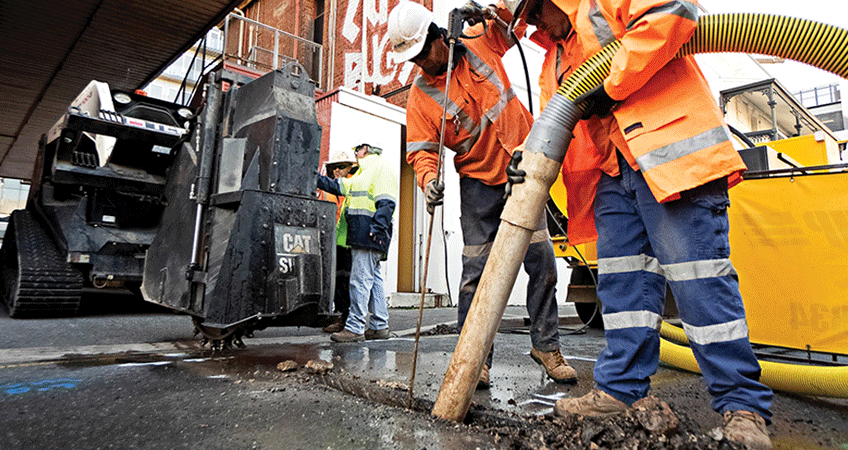This article will answer the question What is vacuum excavation? and explain how the process works, as well as the benefits of hydro excavation. If you’re trying to decide on the best method for your construction needs, hopefully this will bring you clarity.
Hydro excavation, also known as vacuum excavation, is a procedure that uses pressurised water and a vacuum system to remove huge volumes of dirt from an excavated area swiftly.
Traditional excavation techniques require heavy machinery such as backhoes or, for more delicate excavations, a dig team physically breaking up and removing dirt with shovels. However, these traditional techniques have restrictions that make them unsuitable for many applications. For one thing, physical digging is time-consuming and exhausting.
Furthermore, picks, shovels, and other metal hand tools are sharp devices that might accidentally hit and destroy subsurface infrastructure. Heavy mechanical digging is quicker than hand digging, but it also can damage subsurface utility service connections further.
This article will discuss hydro excavation, including how the process works and the benefits of hydro excavation.
Hydro Excavation: How Does It Work?
Hydro excavation equipment is usually in the form of specially constructed trucks or trailers that include all components required for hydro excavation with HDD mining. The following are the primary functional components of the hydro-excavating device:
- One or even more onboard water tanks with fresh water supply will be utilised to create a pressurised jet of water to cut through the dirt.
- A motorised pump system that increases the pressure of the water jet to several thousand psi, equivalent to pressure washer levels, and high enough pressure levels to readily cut through dirt and compacted terrain
- A suction hose-equipped articulating boom that directs the slurry combination of dirt and water from the excavation area back onto the truck or trailer’s storage tank
- A vacuum blower or pump system produces suction on the vacuum hoses to recover the slurry.
- A trash tank large enough to hold the deposited slurry pulled by the vacuum system.
- Some variants have a boiler that can heat the water before pressuring, allowing the hydro excavator to be utilised even when the ground is frozen.
An operator guides the pressurised water jet to the ground region where the excavation will occur. As the water enters and combines with the soil, the jet quickly cuts through any grass or topsoil and loosens it.
A second operator utilises the articulating boom, which houses the vacuum system and hoses, to suck away the loosened combination of water and dirt, allowing the water jet to remove other soil at lower depths. This procedure is repeated until the required depth and size of the excavation are reached.
Once the operation is over, the hydro-vac truck or trailer must be taken to a designated dumping area where the collected slurry mixture may be offloaded and the debris tank cleaned and ready for future usage.
Benefits of Hydro Excavation
Hydro excavation with HDD mining has various advantages over manual digging or hydraulic-powered heavy machines. The following are the primary benefits:
Cost Reduction
Compared to manual digging, a hydro-vac truck requires a smaller work team to perform a given-size project. Combining a smaller team and a speedier operation immediately translates into lower excavation expenses.
Precision
Hydro excavation provides more accurate incisions in the dig area by using a forceful and narrow stream of high-pressure water to remove dirt. Because of this accuracy, less soil is disturbed than in other excavation techniques, resulting in easier restoration when backfilling the excavation site.
Non-destructive Process
When daylighting and excavating subsurface utilities, hydro excavation is considerably safer than hand digging with picks and shovels or utilising heavy gear, which may harm existing infrastructure. According to some estimates, shovel impacts cause 75% of all damage in the utility business.
Reducing the danger of injury reduces downtime and the expense of subsequent excavation-related repairs. The water jet also cleans the underground infrastructure of debris and dirt, making it easier to execute repairs.
Excavation Efficiency and Speed
The hydro excavation method is far quicker than hand digging, enabling what would otherwise take days to complete to be accomplished in hours.
Reduction of Injuries
Hydro excavation is a safer method of dirt removal that results in fewer injuries to employees and lesser dangers to others in the surrounding region.
Extended Construction Season
Hydro excavation equipment may be outfitted to utilise hot water to break through frozen ground, extending construction work into colder weather months and taking place in northern climes where traditional digging techniques would be impractical.
The one disadvantage of hydro excavation is that since the excavated soil is combined with water before being sucked up, it is in the form of a slurry, which is not a suitable backfill for the excavated area after repairs/installations are finished. This constraint mandates the delivery of clean fill to the project site to return the site to its original state.
When doing manual or extensive machine digs, it is common to practise staging the excavated soil someplace on-site and then use it for backfill after the building activity is over.
Conclusion
You can use hydro excavation for gardening, servicing sewer and cesspool connections for homes, and cleaning dirt and garbage from a residence or building site.
A supplier offers high-quality tanks and vacuum systems that meet your company’s demands, budget, and project specifications. They have created strong, dependable industrial equipment. They also have access to knowledgeable employees, 24-hour assistance, and a large inventory of components. If you select the best supplier, you will never have to worry about downtime.
